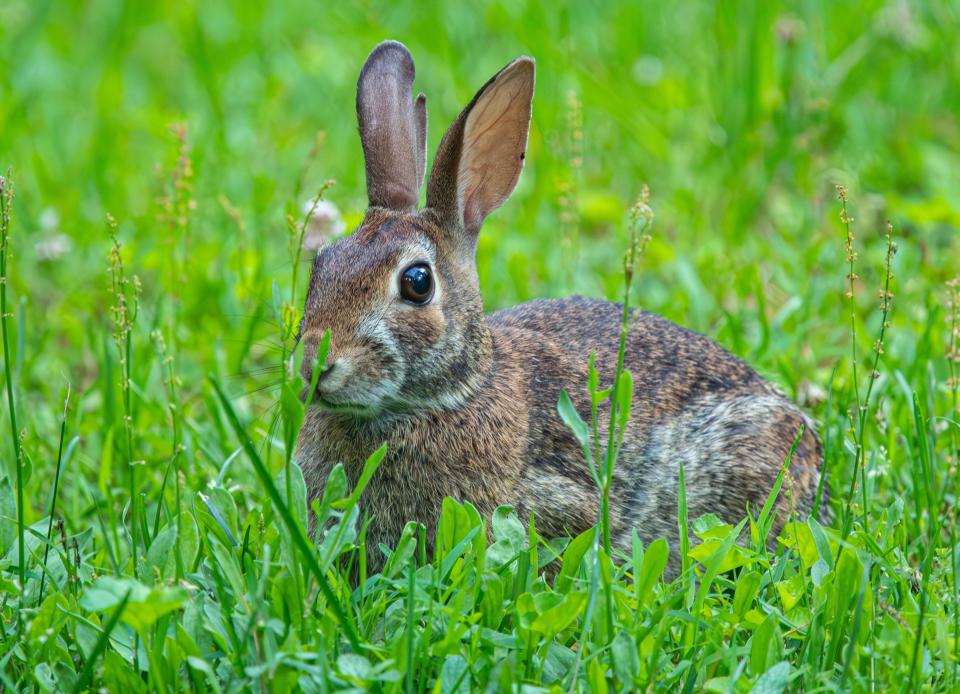Chinese Year of the Rabbit brings many questions | ECOVIEWS
The Chinese Year of the Rabbit, 2023, arrived in January. I do not propose a cause-and-effect connection or believe that conspiracy is in play, but we have seen more rabbits in our backyard this year than any since the previous Year of the Rabbit, 2011. OK, coincidence. Nonetheless I shall honor the special year by answering questions about rabbits.

Q. We used to see rabbits in our neighborhood but not this year. Where have they gone?
A. At the risk of flippancy, I would say they are in my yard. Actually, I believe I have more rabbits this year because I put corn kernels on the ground daily. Since rabbits are not afraid of squirrels, they share and share alike. However, the usual explanation for the appearance and disappearance of wild animals anywhere is because fluctuations in animal numbers from year-to-year are a universal natural phenomenon. The numbers observed may vary greatly across years and geographic regions.
Population sizes typically oscillate for most animals, often in response to the balance between predators and prey in an area or atypical weather conditions. Unless an unnatural problem such as pollution, pesticides or habitat destruction persists, numbers will eventually return to what has been more commonly observed. But population sizes of most species will continue to fluctuate from year-to-year and place to place. A recent sighting of both a barred owl and a red-tailed hawk in the woods behind our house may lead to the temporary decline in our surplus of rabbits.
More: Ocean's thermal vents produce bizarre life forms | ECOVIEWS
Q. I know that rats, mice and squirrels are rodents, but rabbits belong to a completely different group of mammals. What distinguishes the two groups?
A. Rodents comprise more than one-third of all mammals, around 1,500 to 2,000 species, depending on the source. Lagomorphs include a little over 100 species — rabbits, hares and a little-known group called pikas. Rodents and lagomorphs diverged evolutionarily around 64 million years ago following the extinction of the dinosaurs. A distinctive difference is that rodents have a single pair of upper front teeth (incisors), whereas lagomorphs have two pairs, back-to-back. Rodents and lagomorphs have many other anatomical differences, but the teeth are the most obvious. If someone gives you an Easter pet, you can confirm it is a bunny rabbit and not a white rat by checking its front teeth.
Q. What is the difference between a rabbit and a hare? Also, what about pikas?
A. According to "Rabbits: The Animal Answer Guide" by Susan Lumpkin and John Seidensticker (Johns Hopkins University Press), rabbits and hares are distinctive to biologists, both genetically and in their ancestral relationships. A jack rabbit is a hare, and so, according to the authors, is Bugs Bunny. The well-known cottontails are true rabbits. A Playboy Bunny belongs to an altogether different order of mammals.
In general, hares are bigger than rabbits, have black-tipped ears and will run away to escape rather than bolting into a hole. But reproductive traits are what really set rabbits and hares apart. Rabbits have their babies in a burrow or ground depression in a nest made from their own fur and grass. Baby rabbits are born hairless with their eyes shut, and newborns are completely helpless. Most hares are born with fur and with their eyes wide open, and they are ready to run.
Pikas belong to a family all their own. Tiny, with short, rounded ears, they look like little balls of fluff and are as cute as any bunny. In the United States, pikas are found in the rocky slopes of mountainous regions in the West. One of their distinctive traits is frequent vocalization, including whistling and squeaking sounds.
Will the Chinese Year of the Rabbit bring good fortune to rabbits? Since many people still consider a rabbit’s foot to be a good luck charm, the likely answer is no more than any other year.

Whit Gibbons is professor of zoology and senior biologist at the University of Georgia’s Savannah River Ecology Laboratory. If you have an environmental question or comment, email ecoviews@gmail.com.
This article originally appeared on The Tuscaloosa News: Chinese Year of the Rabbit brings many questions | ECOVIEWS

